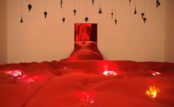[dropcap style=”font-size:100px;color:#992211;”]P[/dropcap]ostmodernity is a condition and it effects us all, no? your cynicism itself may be a result of the anxiety producing collapse of our field of meaning and lack of credible authority to guarantee a sense of purpose. 😉 The sideways glance, wry smile and single cocked eyebrow of the late 20th and early 21st century are all familiar traits in postmodernity. Why not think of an ironic reversal of what I just said and complete the picture! You see, we are trapped in the web, the only serious thing is the tight grip of dread and the nagging feeling that under all the smug apathy something is ever so wrong…
Part 2 of the series: Postmodernism & its Discontents
___________________________________________
In Art ‘Postmodernism’ is characterised by a crisis in three key areas,
- Representation. Postmodernism means working without rules in order to find out the rules of what you’ve done. The question isn’t simply one of further experimentation, but of whose power will legitimate what is done as the right way of doing it!
- Reproduction. The more Van Gogh’s sunflowers become a poster cliché the more you have to pay for the original. This is image consumerism. The reproduced is taking the place of reality or replacing it as hyper-reality. We are living what has already been lived and reproduced with no reality anymore but that of the cannibalized image.
- Legitimation. This refers to power to justify works of art as art. The more experimentation successfully proceeds to diminish the aura and autonomy of art, the more aura and autonomy become the exclusive properties of exhibitive power- the critical establishment, curators, art-dealers and their clients, Introducing Postmodernism,Richard Appignanesi,
Postmodernism contrasts the absolute truth of modernism with the multi-faceted notion of pluralism; that is, universal truths are out and a myriad of authorities which validate various truths is seen as the actual condition of societies,
“Pluralism is a term used in philosophy, meaning “doctrine of multiplicity”, often used in opposition to Monism (“doctrine of unity”) and Dualism (“doctrine of duality”). The term has different meanings in metaphysics, ontology, epistemology and logic,” Joshua Spencer, ‘Ways of being’ 2012
It’s not surprising that the term has various definitions within different disciplines some of these are helpful for us in understanding what the postmodern condition is others are not; suffice to say that the proposed universality asserted in modernist movements loses credibility from the postmodern perspective. Even ideas such as ‘equality’ can be seen as problematic when they undermine a culture which validates its morality from a different authority, the secular west found that its ideas of the universal subject were roundly rejected, for example in the middle east and Asia. This can also be seen as an opportunity to embrace the ideas of alternative civilizations and peripheral voices that had been at the edges of western modernism,
“Postmodern architecture is really to do with pluralism. You’ll find its depth, all of the great post modernism, the philosophy and now in literature, is about pluralism, pluralism, pluralism,” Charles Jencks 2011
There was a feeling after the war(WW2) especially in America, that people wanted to be flattered and pandered to rather than talked down to and lectured. the feeling of modernism was very much an extension of the religious and social elitism familiar to the early 20th and late 20th century publics; the seriousness, the requirement that you be initiated via education into the abstract codes and the idea that ones gauche tastes might need refining had all lost credibility. Money, mass media and popular culture would cheer up post war western societies by establishing ‘fun’ as a dictate of post-modern life.
“I think it was a release from constraint from the design codes – design as a function of the modern era,” Terry Farrell 2012
Although some of the grand concepts of modernism were ignored under the rule of ‘fun’ Farrell’s quote above does remind us that experimentation exploded after the hegemony of the international style was chipped away at; and that this was welcomed by many artists who felt hemmed in by the rules that modernism established (purity, form and function, the classic)
In the creative world pluralism was taking hold creating a sense of equivalence where modernism had established a strict hierarchy,
“If you take the actual broader, philosophical meaning of post modernism, there are no absolutes in art whether it’s architecture, painting, music, literature or whatever,”Robert A M Stern
Irony and doubt where two of the major results of this freeing up. If you are postmodern in this way ironic reactions and posturing make sense in response to a world that makes no sense and in the face of the seriousness of much culture irony attempts to wither that with humour. Doubt can be seen as the effect of not having a solid ‘big other’ or set of dominating values which guarantee hierarchies this is emancipatory but also confusing and destabilising.
So do we get it?
Explaining postmodernism is notoriously difficult, and yet we intuitively understand it, since it is the condition which persists after modernism, a condition we have all inherited and lived with since our birth (if you were born after 1972)
One of the first writers to employ the term ‘postmodern’ was the American literary critic Ihab Hassan. Hassan produced a schematic list of differences between modernism and postmodernism. This list purports to present the changes in focus between modern and postmodern art in terms of the wider questions they raise about representation ( it be viewed here) This list can be very useful in positioning oneself in relation to both modernism and postmodernism; for seeing the advantages of both and the limitations of both.

Michael Eden is a visual artist, researcher and writer at the University of Arts London exploring relationships between monstrosity, subjectivity and landscape representation.


















